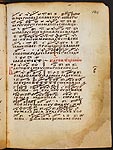Notated Collection of Vocal Music.
1509-1514. Kirillo-Belozersky Monastery. Scribe: Gury Tushin
Q (212 ı 160). 223 + I leaves.
Paper. Ink, cinnabar.
It is written in a semi-uncial script by several hands (change of handwriting on fols. 159r-159v, 161r, 215r-215v); the 16th-century cursive writing. (fols. 2v-4v).
Znamenny notation without red-ink marks (known as the Shaidurov's marks) and black line-signs (the priznaki of Mezenets).
The decoration of the manuscript includes initials and headings in cinnabar. Folio 176v the hymn "God with us" written in cinnabar, notation is designated in black ink.
Folio 5v bears the scribe's inscription stating that the book was created through blessing of Heguman John at the Kirillo-Belozersky Monastery by Coenobite Gury; a note on folio 214r says that the work was begun on the day dedicated to St Antipas the Martyr, and ended on the day celebrated St Stephen the Confessor's memory.
The collection is one of the first noted books, produced at the Kirillo-Belozersky Monastery. It was written during the time when Heguman John was the head of a monastery, so the manuscript dates from between 1506 and 1514. Gury Tushin (1452 or 1455-1526) who wrote the collection was one of the most productive copyist of the monastery. It is known, that he copied 37 books, of which 23 are discovered to the present day. He rewrote works of the Church Fathers, lives of saints, service books, including the Epistle Book and the Gospels. Among manuscripts copied by Gury Tushin is only one notated book. It comprises hymns from the Irmologion, the Octoechos, stichera to particular saints and feasts etc. The book is remarkable both for its decoration (for example, the hymn "God with us" is written in cinnabar, the notation is designated in black ink), and for its contents. It includes one of the earliest copies of stichera to Saint Kirill of Beloozero. In addition, the collection contains an elementary treatise on singing, including moral and theological commentaries on each sign of the notation. Treatises of the same kind became wide-spread during the 17th century, this manuscript contains the oldest from known copies.
The musical-poetic contents of the collection correspond with divers sections of Aprakos-Gospel: hymns to Easter - with readings for Easter, motets for Lent - with readings for Lent, stichera to particular saints and feasts - with the Orthodox Liturgical Calendar.
In 1918 the manuscript came into the State Public Library along with the other materials from the library of the Kirillo-Belozersky Monastery.
Shelfmark: –Õ¡. Ë.-¡ÂÎ. 568/825.





